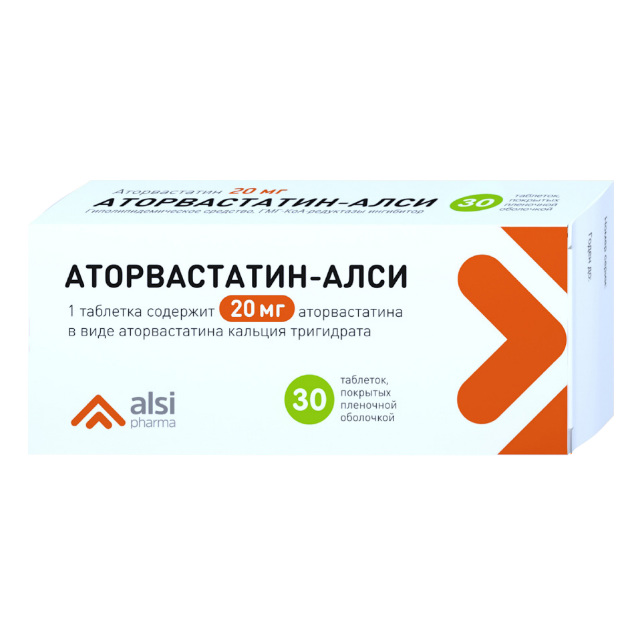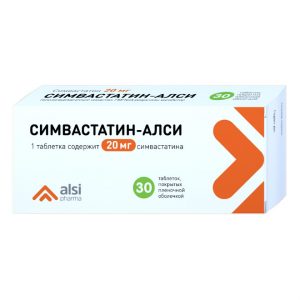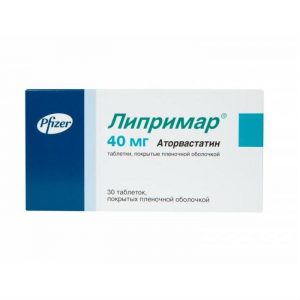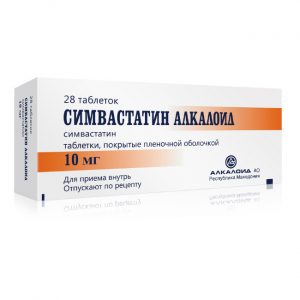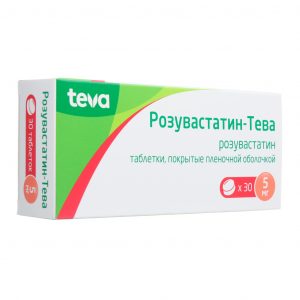Description
Description
Biconvex tablets coated with a white film coating.
Pharmacological action
Hypolipidemic agent from the group of statins. Selective competitive inhibitor of HMG-CoA reductase – an enzyme, converting 3-hydroxy-3-methylglutaryl coenzyme A to mevalonic acid, a precursor of sterols, including cholesterol. Triglycerides (TG) and cholesterol in the liver are included in the composition of very low density lipoproteins (VLDL), enter the blood plasma and are transported to peripheral tissues. Low density lipoproteins (LDL) are formed from VLDL during interaction with LDL receptors. Atorvastatin reduces plasma cholesterol and lipoprotein levels by inhibiting HMG-CoA reductase, the synthesis of cholesterol in the liver and an increase in the number of hepatic LDL receptors on the cell surface, which leads to increased uptake and catabolism of LDL. Reduces the formation of LDL, causes a pronounced and persistent increase in the activity of LDL receptors. Decreases LDL in patients with homozygous familial hypercholesterolemia, which is usually not amenable to hypolipidemic therapy. It reduces the level of total cholesterol by 30-46%, LDL – by 41-61%, apolipoprotein B – by 34-50% and TG – by 14-33% causes an increase in the level of HDL cholesterol (high density lipoproteins) and apolipoprotein A. Dose-dependent lowers LDL levels in patients with homozygous hereditary hypercholesterolemia, resistant to therapy with other lipid-lowering drugs.
Indications
Atorvastatin is used:
in combination with a diet to lower elevated levels of total cholesterol, cholesterol / LDL cholesterol, apolipoprotein B and triglycerides and increase HDL cholesterol in patients with primary hypercholesterolemia, heterozygous familial and non-familial hypercholesterolemia II (mixed) type II hyperreipidemia
in combination with a diet for the treatment of patients with elevated serum levels of triglycerides (Fredrickson type IV) and patients with dysbetalipoproteinemia (Fredrickson type III) who have a dieteter FDI does not provide an adequate effect of
to lower total cholesterol and cholesterol / LDL levels in patients with homozygous familial hypercholesterolemia, when diet therapy and other non-pharmacological treatments are not effective enough.
Contraindications
hypersensitivity to the components of the drug
active liver disease or increased activity of liver enzymes of unknown origin (more than 3 times compared with the upper limit of normal)
liver failure (severity according to Child-Pyug classification A and B)
pregnancy
lactation period
age up to 18 years (efficacy and safety not established).
Precautions: alcohol abuse, a history of liver disease, severe electrolyte imbalance, endocrine and metabolic disorders, arterial hypotension, severe acute infections (sepsis), uncontrolled epilepsy, extensive surgery, trauma, and skeletal muscle disease.
Recommendations for the use of
Before prescribing atorvastatin, the patient should be advised of a standard lipid-lowering diet, which he must continue to follow throughout the duration of therapy.
The initial dose is an average of 10 mg 1 time / day. The dose varies from 10 to 80 mg 1 time / day.
The drug can be taken at any time of the day with food or regardless of the meal time. The dose is selected taking into account the initial levels of cholesterol / LDL, the purpose of therapy and individual effect. At the beginning of treatment and / or during an increase in the dose of Atorvastatin, it is necessary to monitor plasma lipid levels every 2-4 weeks and adjust the dose accordingly.
Primary hypercholesterolemia and mixed hyperlipidemia, as well as type III and IV according to Fredrickson.
In most cases, a dose of 10 mg of Atorvastatin once daily is sufficient. A significant therapeutic effect is observed after 2 weeks, as a rule, and the maximum therapeutic effect is usually observed after 4 weeks. With prolonged treatment, this effect persists.
Homozygous familial hypercholesterolemia.
Assign a dose of 80 mg (4 tablets of 20 mg) 1 time per day.
The use of the drug in patients with renal failure and kidney disease does not affect the level of atorvastatin in the blood plasma or the degree of decrease in cholesterol / LDL when it is used, therefore, changing the dose of the drug is not required.
In case of hepatic insufficiency, the dose should be reduced (see section “With caution” and “Special instructions”).
When using the drug in elderly patients, there were no differences in safety, effectiveness or achievement of the goals of lipid-lowering therapy in comparison with the general population.
Special instructions
Before starting therapy with atorvastatin, the patient must be prescribed a standard hypocholesterol diet, which he must follow during the entire period of treatment.
The use of HMG-CoA reductase inhibitors to lower blood lipids can lead to a change in biochemical parameters that reflect liver function. Liver function should be monitored before starting therapy, 6 weeks, 12 weeks after starting atorvastatin and after each dose increase, and periodically, for example, every 6 months. An increase in the activity of liver enzymes in the blood serum can be observed during therapy with Atorvastatin. Patients with an increase in enzyme levels should be monitored until the enzyme levels return to normal. In the event that the values of alanine aminotransferase (ALT) or aspartic aminotransferase (AST) are more than 3 times the level of the upper acceptable limit, it is recommended to reduce the dose of Atorvastatin or stop treatment.
Atorvastatin should be used with caution in patients who abuse alcohol and / or have liver disease. Active liver disease or a persistent increase in the activity of aminotransferases of unknown origin serve as contraindications to the appointment of Atorvastatin.
Treatment with atorvastatin may cause myopathy. The diagnosis of myopathy (muscle pain and weakness in combination with an increase in the activity of creatine phosphokinase (CPK) by more than 10 times compared with the upper limit of the norm) should be discussed in patients with common myalgia, pain or muscle weakness and / or a marked increase in CPK activity. Patients should be warned that they should immediately inform the doctor about the appearance of unexplained pain or weakness in the muscles, if they are accompanied by malaise or fever. Atorvastatin therapy should be discontinued if there is a marked increase in CPK activity or in the presence of confirmed or suspected myopathy. The risk of myopathy in the treatment of other drugs of this class increased with the simultaneous use of cyclosporine, fibrates, erythromycin, nicotinic acid or azole antifungal agents. Many of these drugs inhibit the metabolism mediated by cytochrome P450 3A4 and / or drug transport. Atorvastatin is biotransformed under the influence of CYP 3A4. When prescribing atorvastatin in combination with fibrates, erythromycin, immunosuppressive drugs, azole antifungal agents or nicotinic acid in lipid-lowering doses, the expected benefit and risk of treatment should be carefully weighed and patients should be regularly observed to detect muscle pain or weakness, especially during the first months of treatment and during periods of increasing doses of any drug. In such situations, periodic determination of CPK activity can be recommended, although such control does not prevent the development of severe myopathy.
When using Atorvastatin, as well as other drugs of this class, cases of rhabdomyolysis with acute renal failure due to myoglobinuria are described. Atorvastatin therapy should be temporarily discontinued or completely discontinued if there are signs of a possible myopathy or a risk factor for the development of renal failure due to rhabdomyolysis (for example, severe acute infection, arterial hypotension, serious surgery, trauma, severe metabolic, endocrine and electrolyte disturbances and uncontrolled seizures).
Before starting Atorvastatin therapy, it is necessary to try to achieve control of hypercholesterolemia by adequate diet therapy, increased physical activity, weight loss in patients with obesity and treatment of other conditions.
Patients should be warned that they should immediately consult a doctor if unexplained muscle pain or weakness occurs, especially if they are accompanied by malaise or fever.
Influence on ability to drive a car and work with mechanisms
No adverse effects of Atorvastatin on ability to drive a car and work with mechanisms were reported.
Composition
One film-coated tablet contains:
active substance: atorvastatin calcium trihydrate – 21.70 mg, which corresponds to 20 mg of atorvastatin
excipients: calcium carbonate – 66.00 mg, microcrystalline cellulose – 96.00 mg, lactose monohydrate (milk sugar) – 47.70 mg, pregelatinized starch (starch 1500) – 65.60 mg, colloidal silicon dioxide (aerosil) – 1.50 mg, magnesium stearate – 1.50 mg, polyvinyl alcohol – 5.00 mg , macrogol (polyethylene glycol) – 2.52 mg, talc – 1.86 mg, titanium dioxide – 3.12 mg
Side effects
From the side of the nervous system – more often 2% – insomnia, dizziness less than 2% – headache, asthenia, malaise, drowsiness, nightmares, paresthesias, peripheral neuropathy, amnesia, emotional lability, ataxia, facial paralysis, hyperkinesis, migraine, depression, hypesthesia, loss of consciousness.
On the part of the sensory organs: less than 2% – amblyopia, ringing in the ears, dryness of the conjunctiva, disturbed accommodation, hemorrhage in the retina, deafness, glaucoma, parosmia, loss of taste, perversion of taste.
From the side of the cardiovascular system: more often 2% – chest pain less than 2% – palpitations, vasodilation symptoms, orthostatic hypotension, increased blood pressure, phlebitis, arrhythmia, angina pectoris.
From the hemopoietic system: less than 2% – anemia, lymphadenopathy, thrombocytopenia.
From the respiratory system: more than 2% – bronchitis, rhinitis less often 2% – pneumonia, dyspnea, exacerbation of bronchial asthma, nosebleeds.
From the digestive system: more often 2% – nausea less than 2% – heartburn, constipation or diarrhea, flatulence, gastralgia, abdominal pain, decreased or increased appetite, dry mouth, belching, dysphagia, vomiting, stomatitis, esophagitis, glossitis, erosive and ulcerative lesions of the oral mucosa, gastroenteritis, hepatitis, biliary colic, cheilitis, duodenal ulcer, pancreatitis, cholestatic jaundice, impaired liver function, rectal bleeding, melena, bleeding gums, tenesmus.
From the musculoskeletal system: more often 2% – arthritis less often 2% – leg muscle cramps, bursitis, tendosynovitis, myositis, myopathy, arthralgia, myalgia, rhabdomyolysis, torticollis, muscle hypertonicity, joint contractures.
From the genitourinary system: more often 2% – urogenital infections, peripheral edema less than 2% – dysuria (including pollakiuria, nocturia, urinary incontinence or urinary retention, imperative urination), nephritis, hematuria, vaginal bleeding, nephrourolithiasis, metrorrhagia, epididymitis, decreased libido, impotence, impaired ejaculation.
From the skin: more than 2% – alopecia, xeroderma, increased sweating, eczema, seborrhea, ecchymosis, petechiae.
Allergic reactions: less than 2% – itchy skin, rash, contact dermatitis, rarely – urticaria, angioedema, facial edema, photosensitivity, anaphylaxis, erythema multiforme exudative (including Stevens-Johnson syndrome), toxic epidermal necrolysis Lyell’s syndrome).
Laboratory indicators: less than 2% – hyperglycemia, hypoglycemia, increased serum CPK, albuminuria.
Other: less than 2% – weight gain, gynecomastia, mastodynia, exacerbation of gout.
Drug interactions
The risk of myopathy during treatment with other drugs of this class increases with the simultaneous use of cyclosporine, fibrates, erythromycin, antifungals related to azoles, and nicotinic acid.
With the simultaneous administration of Atorvastatin and a suspension containing magnesium and aluminum hydroxide, the concentration of Atorvastatin in the blood plasma decreased by about 35%, but the degree of decrease in cholesterol / LDL levels did not change.
With the simultaneous use of atorvastatin does not affect the pharmacokinetics of antipyrine (phenazone), therefore, interaction with other drugs metabolized by the same cytochrome isoenzymes is not expected.
With the simultaneous use of colestipol, plasma concentrations of atorvastatin decreased by approximately 25%. However, the lipid-lowering effect of the combination of atorvastatin and colestipol exceeded that of each drug individually.
With repeated administration of digoxin and atorvastatin at a dose of 10 mg, the equilibrium concentration of digoxin in the blood plasma did not change. However, when using digoxin in combination with Atorvastatin at a dose of 80 mg / day. the concentration of digoxin increased by about 20%. Patients receiving digoxin in combination with atorvastatin should be observed.
With the simultaneous use of atorvastatin and erythromycin (500 mg 4 times / day) or clarithromycin (500 mg 2 times / day), which inhibit cytochrome P450 3A4, an increase in the concentration of atorvastatin in the blood plasma was observed.
With the simultaneous use of atorvastatin (10 mg 1 time / day) and azithromycin (500 mg 1 time / day), the concentration of atorvastatin in the blood plasma did not change.
Atorvastatin did not have a clinically significant effect on the concentration of terfenadine in blood plasma, which is metabolized mainly by cytochrome P450 3A4 in this regard, it seems unlikely that atorvastatin is able to significantly affect the pharmacokinetic parameters of other substrates of cytochrome P450 3A4.
With the simultaneous use of atorvastatin and an oral contraceptive containing norethindrone and ethinyl estradiol, a significant increase in the AUC of norethindrone and ethinyl estradiol was observed by about 30% and 20%, respectively. This effect should be considered when choosing an oral contraceptive for a woman receiving atorvastatin.
Concomitant use with drugs that reduce the concentration of endogenous steroid hormones (including cimetidine, ketoconazole, spironolactone) increases the risk of lowering endogenous steroid hormones (caution should be exercised).
When studying the interaction of Atorvastatin with warfarin and cimetidine, no clinically significant interaction was detected.
With the simultaneous use of Atorvastatin 80 mg and Amlodipine 10 mg, the pharmacokinetics of Atorvastatin in the equilibrium state did not change.
No clinically significant adverse effects of atorvastatin and antihypertensive agents have been observed.
The simultaneous use of atorvastatin with protease inhibitors known as cytochrome P450 3A4 inhibitors was accompanied by an increase in plasma concentrations of atorvastatin.
Pharmaceutical incompatibility not known.
Overdose
Treatment: there is no specific antidote, symptomatic therapy is carried out.
Hemodialysis is ineffective.
Storage conditions
In a dry, dark place at a temperature of no higher than 25 ° C.
Keep out of the reach of children.
Expiration
3 years. Do not use after the expiry date stated on the packaging.
Deystvuyuschee substances
Atorvastatin
Form of Treatment
tablets
Appointment
for Adults on purpose doctor
Indications
prevention of heart attacks and strokes, atherosclerosis
